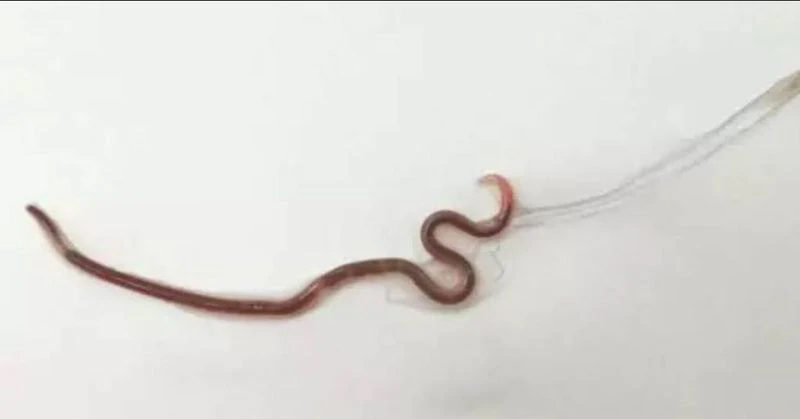Although it originated in Japan, sushi has become a beloved food around the world, and many people enjoy heading out to their favorite all-you-can-eat sushi restaurant with a group of their friends to see how much of the stuff they can scarf down in one sitting.
Given sushi’s raw preparation, however, occasionally you may get more than you bargained for with your meal. No, we’re not talking about when you accidentally order one too many sets of spicy salmon rolls. We’re talking about parasites.
A Tonsil Worm
One 25-year-old woman in Tokyo recently got an unpleasant surprise after a trip to her favorite sushi restaurant. After enjoying a meal of assorted sashimi, she began to suffer from a sore throat. When she finally went to get examined at St. Luke’s International Hospital, doctors found a one and a half-inch worm in her left palatine tonsil [1].
The case report, which was published in the American Journal of Tropical Medicine and Hygiene, revealed that the worm was the larva of Pseudoterranova azarasi, which is a type of parasitic roundworm [2].
It is uncommon for this type of worm to infect the throat or the digestive tract. Normally, they settle in the stomach and require an endoscopy to remove. If it does settle in the throat, it can cause pain, coughing, and “tingling throat syndrome”.
There have been hundreds of Pseudoterranova cases around the world, which are usually solved upon removal of the worm. In the case of the woman in Tokyo, her symptoms noticeably improved once the doctors removed the worm with a pair of tweezers [1].
Related: Parasitic worm populations are skyrocketing in some fish species used in sushi
How Does a Worm End Up in Sushi?
The cycle of a parasitic roundworm is as follows:
A marine mammal, such as a dolphin or a sea lion, eats an infected fish. It then excretes the parasite’s eggs out into the ocean.
Those eggs hatch, and then the larvae swim around until they are ingested by a crustacean.
The fish then eat the infected crustacean, and the larvae infect the fish and burrow into the fish’s mesentery and muscles [3].
If you eat raw or undercooked fish that contain these larvae, they will then infect you. Typically, they make their way down to your stomach or intestines and cause inflammation or damage, or cause an allergic reaction.
The only way to diagnose the presence of a worm is to see it. In most cases, symptoms go away once the worm has been removed.
“Sushi Parasites” are on the Rise
A recent study published in the journal Global Change Biology determined that the number of parasitic nematodes (aka worms) found in fish are on the rise. The researchers found that between 1967 and 2017, the number of Anisakis, another genus of worm found in raw fish, increased by 283 times [4].
The study authors explained that not only could this affect human health, but it could also threaten marine animal populations. Chelsea Wood, assistant professor at the University of Washington School of Aquatic and Fishery Sciences, says that people are good at finding worms and removing them at every stage of seafood processing and sushi-making process, but their effect on marine life is often not considered.
“It’s not often considered that parasites might be the reason that some marine mammal populations are failing to bounce back,” she says. “I hope this study encourages people to look at intestinal parasites as a potential cap on the population growth of endangered and threatened marine mammals.” [1]
Should You Still Eat Sushi?
Despite her field of research, Wood still enjoys eating sushi regularly, and although the occurrence of worms in marine animals appears to be increasing, ingesting a worm while eating sushi is still quite rare.
For those of you who still want to enjoy sushi but are very concerned about eating a worm, Wood suggests cutting each piece in half and checking for worms before eating it [5].
Additionally, you should always make sure that the sushi restaurant you are at uses the proper techniques and is getting their fish from reputable sources. Reputable restaurants with trained staff will know how to handle the fish as per FDA recommendations, such as ensuring it be flash frozen prior to preparation [6].
If you’re still feeling uncertain, you can always skip it altogether. Cooking your fish completely will kill off any parasites or bacteria in your fish, leaving you with little to no risk.
Keep Reading: Beyond Meat and its rivals rely on Chinese ingredients. How Safe is Our Food Really?
- https://nypost.com/2020/07/10/doctors-pull-1-5-inch-worm-from-womans-tonsils-after-she-ate-sashimi/
- https://www.ajtmh.org/content/journals/10.4269/ajtmh.20-0175
- https://www.forbes.com/sites/brucelee/2020/07/11/tingling-throat-syndrome-woman-has-15-inch-worm-in-her-tonsils/#6c9ca7993e66
- https://onlinelibrary.wiley.com/doi/abs/10.1111/gcb.15048
- https://www.sciencedaily.com/releases/2020/03/200319090232.htm
- https://share.upmc.com/2018/03/sushi-safety-risks/

